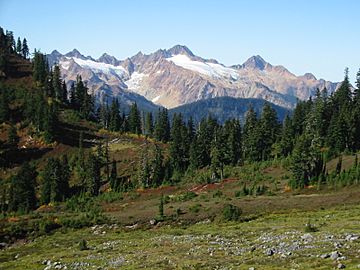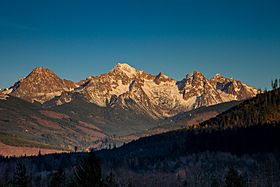Twin Sisters Mountain facts for kids
Quick facts for kids Twin Sisters Mountain |
|
|---|---|

As seen from southern flank of Mount Baker
|
|
| Highest point | |
| Elevation | 7,000+ feet (2,130+ m) |
| Prominence | 3,520 ft (1,070 m) |
| Geography | |
| Location | Whatcom County, Washington, U.S. |
| Parent range | Cascade Range |
| Topo map | USGS Twin Sisters Mountain |
| Geology | |
| Mountain type | Igneous dunite |
Twin Sisters Mountain (Nooksack: Kwetl’kwítl’ Smánit, "red mountain"), commonly called the Twin Sisters, is a mountain in the U.S. state of Washington. Part of the Cascade Range, it lies just southwest of Mount Baker. Of its two main peaks, South Twin is higher, with a summit elevation above 7,004 feet (2,135 m). The summit of North Twin is above 6,644 feet (2,025 m). There are several glaciers on the northeast slopes of Twin Sisters Mountain.
Geography
Both of the summits are located within Mount Baker Wilderness. Twin Sisters Mountain as a whole is located southwest of Mount Baker, separated from the volcano by the Middle Fork of the Nooksack River. The South Fork Nooksack River flows around the eastern end of Twin Sisters Mountain. Other streams that drain Twin Sisters Mountain include Skookum Creek, Sister Creek, Green Creek, and Howard Creek. All the streams eventually end up in the Nooksack River.
Geology
Twin Sisters Mountain is composed of relatively unaltered dunite, an ultramafic rock that is mostly olivine. The Twin Sisters Range is a massive slab of relatively dense rock that was uplifted from major thrust fault activity in the form of a nappe. The magnesium and iron rich rock was forced upwards from the tectonic collision between the Bell Pass Mélange and the Chilliwack River terrane during the Mesozoic era. The reddish color of the mountain range may be due to the oxidation of iron and magnesium in the dunite that is exposed to chemical weathering. Petrology of the Twin Sisters dunite consists of Enstatite rich rocks that contain, along with olivine, significant amounts of chromite, clinopyroxene, and serpentinite. These minerals are commonly associated with ultramafic rocks that crystallize below the Earth's crust within the mantle (geology). The serpentinized minerals are thought to have formed during later stages of the uplift where water could penetrate through fault fractures and initiate metamorphism.
Climate
Twin Sisters are located in the marine west coast climate zone of western North America. Most weather fronts originate in the Pacific Ocean, and travel northeast toward the Cascade Mountains. As fronts approach the North Cascades, they are forced upward by the peaks of the Cascade Range (Orographic lift), causing them to drop their moisture in the form of rain or snowfall onto the Cascades. As a result, the west side of the North Cascades experiences high precipitation, especially during the winter months in the form of snowfall. During winter months, weather is usually cloudy, but, due to high pressure systems over the Pacific Ocean that intensify during summer months, there is often little or no cloud cover during the summer Because of maritime influence, snow tends to be wet and heavy, resulting in high avalanche danger.



